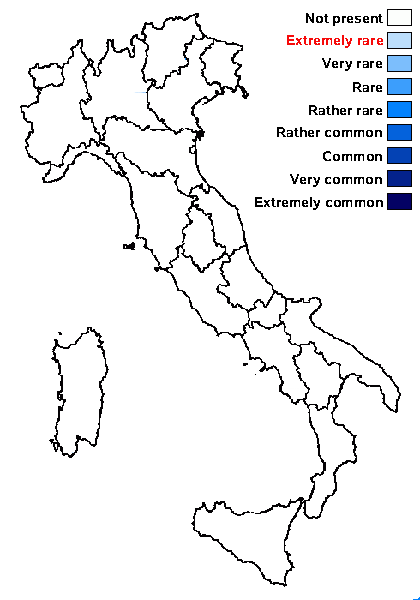Verrucaria consociata Servít
Věstn. Král. České Společ. Nauk, Třída Math.-Přírod., 4: 2, 1951
Synonyms:
Distribution:
Description: Thallus crustose, episubstratic, not gelatinous when wet, greenish to olive-green when dry, turning blackish when wet, 40-60 µm thick, forming indistinctly cracked patches of granulose goniocysts. Cortex absent, but upper parts of thallus paraplectenchymatous, with a yellowish-brown pigment; algae sparse or clustered. Perithecia black, globose, 0.15-0.18 mm across, prominent, the upper half mostly naked or partly covered by a thin thalline layer. Involucrellum absent or very thin, adpressed to exciple and hardly distinguishable; exciple brownish throughout; hamathecium of up to 18 μm long periphyses and periphysoids, interascal filaments absent; hymenial gel hemiamyloid, I+ red (I+ blue at very low concentrations of I), K/I+ blue. Asci 8-spored, clavate, I-, fissitunicate, the wall thickened above, with an ocular chamber, dehiscent by extrusion of an endotunica to form a delicate rostrum, Verrucaria-type. Ascospores 1-celled, hyaline, ellipsoid, 16-28 x 8-13 µm. Photobiont chlorococcoid. Spot tests: K-, C-, KC-, P-, UV-. Chemistry: without lichen substances. Note: on shaded, temporarily wet siliceous rocks, also reported to form small patches on other Verrucaria-species (type!); widespread in Central Europe, with a single record from the Western Alps (France). To be looked for in Italy.
Growth form: Crustose
Substrata: rocks
Photobiont: green algae other than Trentepohlia
Reproductive strategy: mainly sexual
Periodically submerged (e.g. in creeks)

Predictive model
Growth form: Crustose
Substrata: rocks
Photobiont: green algae other than Trentepohlia
Reproductive strategy: mainly sexual
Periodically submerged (e.g. in creeks)

Predictive model
 Index Fungorum
Index Fungorum
 GBIF
GBIF

